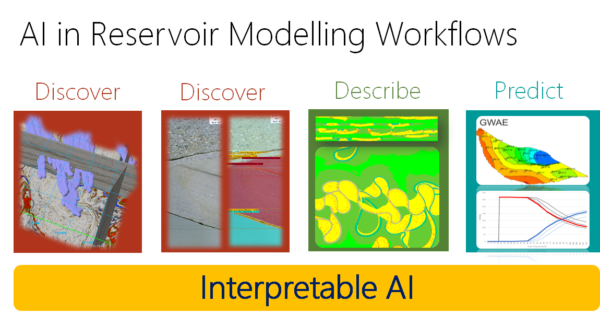Modern developments of AI tech open outstanding opportunity to handle generic tasks with the methods designed to handle diverse and noisy data: st
arting from interpretation of exploration data, coming up with reservoir modelling concepts, describing reservoir characteristics and property distribution, integration of dynamic data and model calibration and update as new data become available.
AI can discover patterns in data, describe complex geological patterns with dependencies learned from data, adapt models to data and search for a range of possible optimal development options subject to uncertainty. Effective AI application to reservoir modelling workflows relies on the ability to ensure interpretability of the machine learning model outcomes. This can be achieved by embedding the domain context into the AI model structure, so the data are no longer treated as merely digital values but the variables with physical meaning and interpretation in the subsurface context.
This overview demonstrates a few examples from
the recently completed PhD theses of how AI tech can help elicit and describe uncertainty in a geologically consistent way to ensure realism of geological interpretations and geomodel outcomes. The AI applications represent several steps of reservoir modelling workflow:
- AI seismic segmentation and geobody interpretation with unsupervised learning [1].
- Constrain geological conceptual modelling with learning from outcrops [2].
- Populate facies in meandering fluvial reservoir models based on learning from depositional process modelling with generative adversarial networks (GANs) [3].
- Dynamic and static data integration with variational autoencoders and uncertainty representation via latent space to predict reservoir dynamics [4].
The work demonstrates how to gain better understanding and representation of associated geological uncertainty when geological domain knowledge is embedded into the AI algorithms’ structure.

More details:
Uncertainty in AI Based Reservoir Modelling Workflows, by V. Demyanov, Q. Corlay, A. Nathanail, C. Sun, G. Shishaev, D. Arnold,
GEOSTATS 2024 ● 12th International Geostatistical Congress ● Azores ● 2-6 September 2024
[1] Dr
Quentin Corlay, 2023:
Detection of Geobodies in 3D Seismic using Unsupervised Machine Learning
[2] Dr
Athanasios (Athos) Nathanail, 2023:
Capturing interpretational uncertainty of depositional environments with Artificial Intelligence,
[3] Dr
Chao Sun, 2023:
Use of Generative Learning to Improve Realism in Fluvial Facies Modelling
[4] Dr
Gleb Shishaev, 2024:
History Matching and Uncertainty Quantification of Reservoir Performance with Generative Deep Learning and Graph Convolutions
 More details:
Uncertainty in AI Based Reservoir Modelling Workflows, by V. Demyanov, Q. Corlay, A. Nathanail, C. Sun, G. Shishaev, D. Arnold, GEOSTATS 2024 ● 12th International Geostatistical Congress ● Azores ● 2-6 September 2024
[1] Dr Quentin Corlay, 2023: Detection of Geobodies in 3D Seismic using Unsupervised Machine Learning
[2] Dr Athanasios (Athos) Nathanail, 2023: Capturing interpretational uncertainty of depositional environments with Artificial Intelligence,
[3] Dr Chao Sun, 2023: Use of Generative Learning to Improve Realism in Fluvial Facies Modelling
[4] Dr Gleb Shishaev, 2024: History Matching and Uncertainty Quantification of Reservoir Performance with Generative Deep Learning and Graph Convolutions
More details:
Uncertainty in AI Based Reservoir Modelling Workflows, by V. Demyanov, Q. Corlay, A. Nathanail, C. Sun, G. Shishaev, D. Arnold, GEOSTATS 2024 ● 12th International Geostatistical Congress ● Azores ● 2-6 September 2024
[1] Dr Quentin Corlay, 2023: Detection of Geobodies in 3D Seismic using Unsupervised Machine Learning
[2] Dr Athanasios (Athos) Nathanail, 2023: Capturing interpretational uncertainty of depositional environments with Artificial Intelligence,
[3] Dr Chao Sun, 2023: Use of Generative Learning to Improve Realism in Fluvial Facies Modelling
[4] Dr Gleb Shishaev, 2024: History Matching and Uncertainty Quantification of Reservoir Performance with Generative Deep Learning and Graph Convolutions
